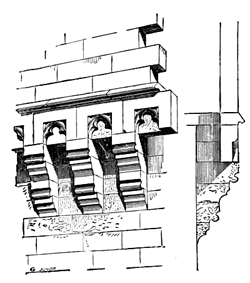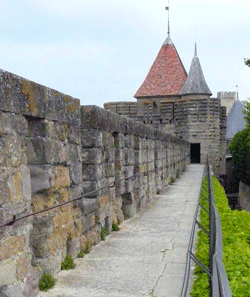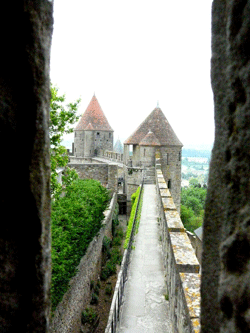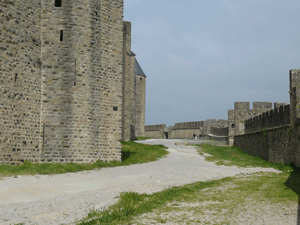Battlements & Crenelations
Taluses
Bossing
Hourdes
Machiolations (Machicoulis)
The Brattice (Breteche)
Chemins de Rondes
Lists (Lices)
Slighting
Battlements & Crenellations
|
|
|
|
Carcassonne
|
|
|
Taluses
|
|
Defensive walls were often built thicker at the bottom. This made it more difficult for attackers in two ways. This thickness often tapered as shown in the accompanying diagrams. This tapered thickness is known as a talus. First, attackers would have a more diffult job in breaking through or undermining the wall because of its great mass. Second, attackers would have greater difficulty in moving siege engines up against a talused wall - to reach the top of the wall they required not only height but a substantial overhang. |
|
Bossing
|
According to several text on catapults, bossing was a means of strengthening a wall against heavy shot. The projection dispersed the energy of the stone shot and prevented a direct energy transfer to the wall. Its use pre-dates Rome. The technique is similar to the modern use of spaced armour on tanks |
|
Hourdes
|
Hourds are defensive wooden structures built onto the top of a defensive wall. They would then be covered in the wetted skins of freshly slaughtered animals to minimise the risk of attackers being able to set fire to them. Hourdes could be assembled when trouble threatened - in times of peace they were not needed. Walls built to bear hourdes have a characteristic row of double holes ready to take the supporting wooden beams. Hourds have been reconstructed on the Chateau Comptal at Carcassonne as shown on the right. |
|
|
|
|
|
|
|
|
|
|
|
|
|
|
|
|
Machiolations (Machicoulis)
|
Where the expense was too great for full scale machilations around a wall, an cheaper alternative was to build them just over weak spots like doors and gateways. This is the origin of the brattice - see below. |
|
|
Machiolations became such a common. and prestigious, feature of medieval architecture that they were used long after they were needed for military purposes. You will for example see them on many nineteenth century buidings, sometimes real machiolations but more often pretend ones. In the Languedoc you can see good examples on the unusaul triangular keep at Beaucaire in the Gard département.
|
|
The Brattice (Breteche)
|
|
|
Chemins de Rondes
|
|
|
|
|
Lists (Lices)
|
|
The Lists is the area between the inner and outer defensive walls.
|
|
|
|
Jousts were often conducted in the lists - hense the expression "to join the lists" - meaning to sign up for a fight |
|

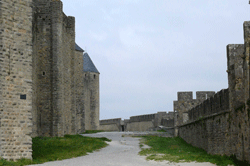
Slighting
|
Often, once a castle was taken, it would be occupied by its new masters and it would continue its function of holding down a strategically important area. Occasionally this was not done. Perhaps the castle could not be held because forces were needed elsewhere (as happened during the Cathar Wars), or because it was untenable with a large hostile population (again as happened during the Cathar Wars). Perhaps the castle was taken only for puniutive reasons (as happened during the Cathar Wars, Spanish incursions, and during the Hundred Year's Wars). Or perhaps the strategic importance diminished, as for Carcassonne and its five sons after the border between France and Spain was moved back under the Treaty of the Pyrenees in 1649. |
|
In each case there was good reason for destroying the castle before leaving it and allowing it to be re-occupied. But destroying a castle is not easy. Generally it was good enough to do just enough damage to make it not worth while for anyone to repair it. To damage a castle in this way is to "slight" it. By analogy we talk about slighting people too - not desroying them but damaging them.
The castle at Beaucaire was slighted by Richelieu in 1632, and so were the "Five Sons of Carcassonne", five Royal castles (Termes, Aguila, Peyrepertuse, Queribus and Puilaurens) strategically placed to defend the old border against Aragon. In 1652 Richelieu ordered the castle at Termes to be abandoned and slighted. The walls were destroyed by a master mason from Limoux, using explosives, between 1653-1654.




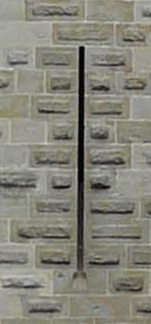



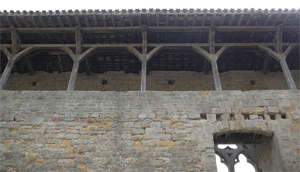


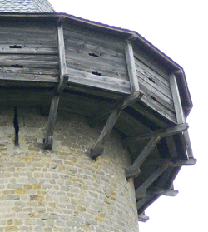
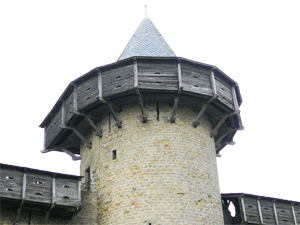

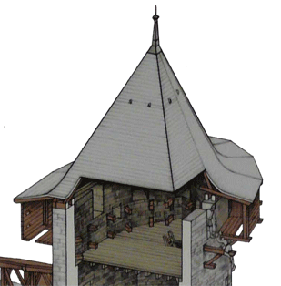

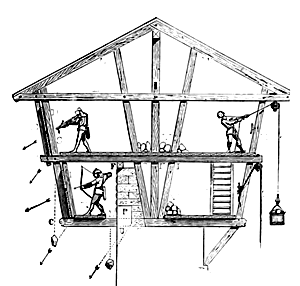

 Maciolations
(Fr Machicoulis) are in effect stone versions of hourdes.
They represent an additional level of sophistication
and expense. Like hourdes they enabled defenders to
shoot at and drop things on their attackers, while
minimising the risk of danger themselves. The great
advantages were
Maciolations
(Fr Machicoulis) are in effect stone versions of hourdes.
They represent an additional level of sophistication
and expense. Like hourdes they enabled defenders to
shoot at and drop things on their attackers, while
minimising the risk of danger themselves. The great
advantages were